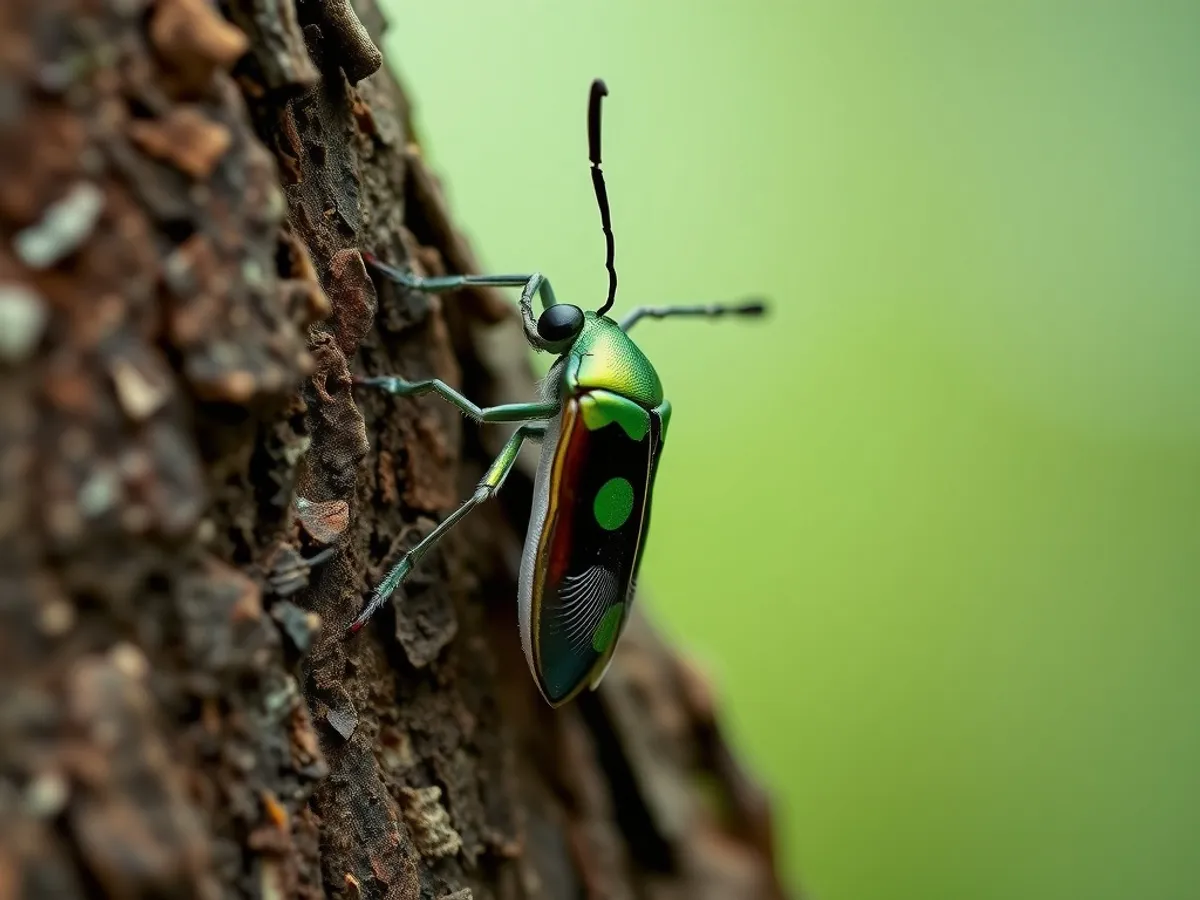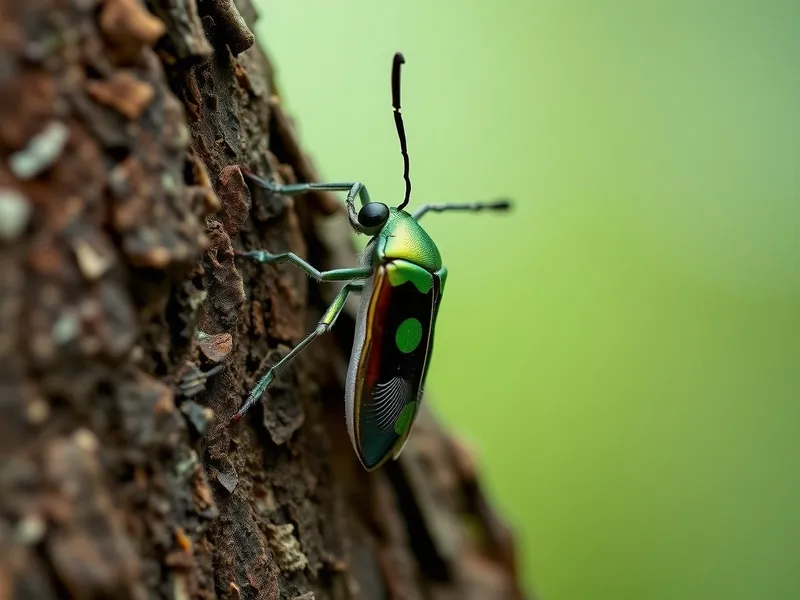
Emerald Ash Borer
Agrilus planipennis

Meet the Emerald Ash Borer
The Emerald Ash Borer is a small, metallic green beetle native to northeastern Asia. It is known for its destructive impact on ash trees, as its larvae feed on the inner bark, disrupting the tree's ability to transport water and nutrients. Since its accidental introduction to North America in the early 2000s, it has caused the death of millions of ash trees across forests and urban areas. Adult beetles are slender and about half an inch long, while the larvae are creamy white and flattened.
Classification
Invertebrate
Habitat
Deciduous forests, woodlands, and urban areas with ash trees
Diet
Herbivore
Lifespan
1-2 years
Conservation
Least Concern
Weight
0.05-0.2 grams
📖Fascinating Facts
Ash Tree Specialist
Emerald Ash Borers feed almost exclusively on ash trees (genus Fraxinus), making them a serious threat to these species.
Bright Appearance
Adults are easily recognized by their vibrant metallic green color, which helps them blend in with foliage.
Invasive Impact
Since arriving in North America, the Emerald Ash Borer has killed hundreds of millions of ash trees, drastically altering ecosystems and urban landscapes.
📋Detailed Description
The Emerald Ash Borer (Agrilus planipennis) is a slender, metallic green beetle measuring approximately 8.5–14 mm in length and 3.1–3.4 mm in width. Its elytra (wing covers) are iridescent green, while the dorsal surface of the abdomen is a distinctive purplish-red, visible when the wings are open. The head is flat and shield-shaped, with large, black, kidney-shaped compound eyes adapted for detecting host trees. Antennae are serrate and relatively short. Adults are strong fliers, capable of dispersing several kilometers, though most remain close to their emergence site. The species is univoltine (one generation per year) in most of its introduced range, but development can extend to two years in cooler climates. Larvae are legless, creamy-white, and flattened, with bell-shaped segments and a pair of brown pincers (urogomphi) at the posterior. Larvae create serpentine galleries in the phloem and outer sapwood, disrupting nutrient and water transport. The beetle is cryptic in behavior, with adults active primarily during warm, sunny days. Its lifecycle is closely tied to the phenology of ash trees (Fraxinus spp.), with adults emerging in late spring to early summer.
💡 Did you know?
Despite its tiny size, the Emerald Ash Borer is considered one of the most destructive forest pests ever introduced to North America.
🔬Research & Sources
Wikipedia Summary
The emerald ash borer, also known by the abbreviation EAB, is a green buprestid or jewel beetle native to north-eastern Asia that feeds on ash species. Females lay eggs in bark crevices on ash trees, and larvae feed underneath the bark of ash trees to emerge as adults in one to two years. In its native range, it is typically found at low densities and does not cause significant damage to trees native to the area. Outside its native range, it is an invasive species and is highly destructive to ash trees native to Europe and North America. Before it was found in North America, very little was known about the emerald ash borer in its native range; this has resulted in much of the research on its biology being focused in North America. Local governments in North America are attempting to control it by monitoring its spread, diversifying tree species, and through the use of insecticides and biological control.
Last Modified: 5/25/2025
🎭Behavior & Social Structure
Emerald Ash Borers are primarily solitary, with limited social interaction beyond mating. Adults feed on ash foliage, causing minor damage, but the larvae are the primary destructive stage, tunneling beneath the bark. Adults are diurnal and most active during midday when temperatures exceed 25°C. They exhibit strong host fidelity, using visual and olfactory cues to locate suitable ash trees. Females are capable of laying 60–90 eggs in their lifetime, depositing them individually in bark crevices. After emergence, adults typically remain on or near the same tree, though some disperse to new hosts. The beetle's cryptic coloration and behavior help avoid predation. Natural enemies in its native range include parasitoid wasps and woodpeckers, but these are less effective in introduced regions.
👶Reproduction & Life Cycle
Mating occurs on the bark or foliage of ash trees, typically within a week of adult emergence. Males locate females using visual cues and pheromones. After mating, females oviposit eggs singly or in small groups in bark crevices or under bark scales, preferring areas with thin bark. Eggs hatch in 7–10 days, and larvae immediately bore into the phloem. Larval development lasts 1–2 years, depending on temperature and tree health. Pupation occurs in the outer sapwood or bark, with adults emerging by chewing D-shaped exit holes (3–4 mm wide). There is no parental care; all life stages are independent after oviposition. In North America, the beetle typically completes its lifecycle in one year, but two-year cycles are observed in colder climates or stressed trees.
🛡️Adaptations & Survival
A. planipennis exhibits several adaptations for survival and host exploitation. The metallic green exoskeleton provides camouflage among foliage and bark. Larvae are adapted for life beneath bark, with flattened bodies and strong mandibles for chewing through phloem and sapwood. Adults have well-developed flight muscles, facilitating dispersal. The beetle's lifecycle is synchronized with host tree phenology, ensuring larvae have access to nutrient-rich tissues. Females can detect volatile organic compounds emitted by stressed or dying ash trees, enhancing host selection. The species' ability to exploit multiple ash species and tolerate a range of climates has contributed to its invasive success.
🎨Cultural Significance
While the Emerald Ash Borer itself holds little positive cultural significance, its impact has been profound in regions where ash trees are culturally and economically important. Ash wood has traditional uses in furniture, tool handles, and baseball bats, and ash trees are valued in urban landscapes for their shade and aesthetic qualities. The beetle's invasion has led to increased public awareness of invasive species and forest health. In some areas, the loss of ash has been commemorated in art and literature, symbolizing broader environmental challenges.
🔬Recent Research & Discoveries
Recent research has focused on the beetle's genome, host selection mechanisms, and the development of early detection methods (e.g., pheromone traps, remote sensing). Studies have documented the efficacy of introduced parasitoids and the potential for resistance breeding in North American ash species. Ongoing work examines the ecological consequences of ash loss, including changes in forest composition and impacts on associated wildlife. Advances in systemic insecticides and integrated pest management are being evaluated for urban and high-value trees. International collaboration continues to improve understanding of the beetle's biology and inform management strategies.
🎥Wildlife Videos

Invasive Species - Emeralds Ash Borer
The emerald ash borer is killing trees all around the Great Lakes and is spreading through the United States. Not only is it killing ...
Awesome Videos

Emerald Ash Borer • An Odyssey
New York State Parks and DEC teamed up with the Excelsior Conservation Corps this spring to produce an entertaining yet ...
NYSDEC

The Lifecycle of the Emerald Ash Borer
http://www.mda.state.mn.us This video was produced by MDA through a unique collaboration with faculty and students of Art ...
mnagriculture

How The Emerald Ash Borer Has Devastated Forests
These squiggly lines on ash trees were not made by artists. They're made by emerald ash borer (EAB) larvae, and they show us ...
Great Lakes Now

WATCH THIS! Emerald Ash Borer #invasivespecies
Buy #firewood where you burn it to stop the spread of tree-killing insects such as the Emerald Ash Borer. Learn more at ...
Texas Parks and Wildlife

Emerald Ash Borer on a Red Oak Tree
Get up close with one of nature's most destructive pests in our latest video: "Emerald Ash Borer Invasion: Red Oak Edition".
Advanced Tree & Shrub Care, Inc
🌍Habitat Information
The Emerald Ash Borer typically inhabits Deciduous forests, woodlands, and urban areas with ash trees environments. Emerald Ash Borers have adapted to their environments with specialized features and behaviors.
Primary Habitat:
Deciduous forests, woodlands, and urban areas with ash trees
More detailed habitat information will be available soon.
🛡️Conservation Status
The Emerald Ash Borer is currently classified as Least Concern. Conservation efforts are crucial for preserving this species for future generations.
Common Threats:
- 🏠Habitat loss and fragmentation
- 🌡️Climate change impacts
- 🎯Hunting and poaching
- 🏭Human-wildlife conflict
⚠️Threats & Conservation Challenges
In its native range, populations are regulated by co-evolved natural enemies and resistant host trees. In introduced regions, such as North America and parts of Europe, the lack of effective natural predators and the high susceptibility of native ash species have led to explosive population growth and widespread tree mortality. Human activities, particularly the movement of infested firewood and nursery stock, have facilitated rapid spread. Management is challenged by the beetle's cryptic life stages and the difficulty of early detection. Biological control efforts using parasitoid wasps (e.g., Tetrastichus planipennisi, Oobius agrili) are ongoing, but long-term effectiveness is still under study. The loss of ash trees has significant ecological and economic impacts, including reduced biodiversity, altered forest structure, and costs associated with tree removal and replacement.
🔬Scientific Classification
Scientific Name
Agrilus planipennis
Classification Hierarchy
🔍 About Taxonomic Classification
Taxonomic classification is a hierarchical system used by scientists to classify and organize living organisms based on shared characteristics and evolutionary relationships.
The system moves from broad categories (Kingdom) to increasingly specific ones, with each animal's scientific name typically consisting of its Genus and species.
📝Community Notes
Share your observations and insights about the Emerald Ash Borer with our community of wildlife enthusiasts.
Join Our Community
Sign in to share your observations and connect with fellow wildlife enthusiasts.
Sign In to ContributeNo community notes yet
Be the first to share your observations about the Emerald Ash Borer!
Explore Emerald Ash Borer
Select a tab above to learn more about this amazing animal.
📸Photo Gallery
No photos available for this animal yet.
🌟Discover More Wildlife
Continue your journey of discovery with more fascinating animals from our database
